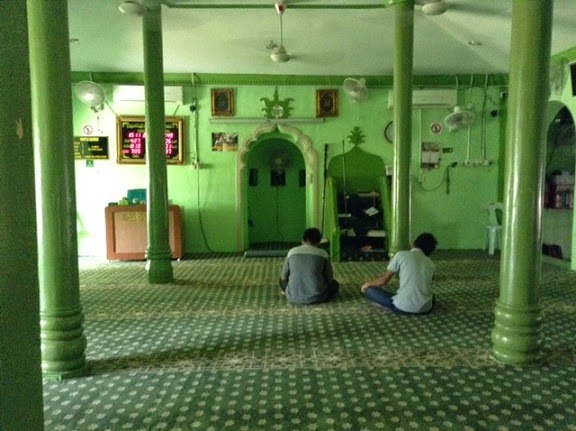Alhamdulillah, we were able to visit Masjid Batu Uban where its founder and first imam Haji Muhammad Saleh or Nahkoda Nan Intan were buried. We were not too sure which was the exact maqam but inclined to believe it's one of the two located inside a demolished wall at the foot of a Banyan tree.
 |
| Two graves within a demolished wall on the south side of Batu Uban mosque. The one on the left side is marked as per below photo. The one on the right is unmarked. |
 |
| Al-Fatihah Shaykh Muhammad Saleh ibni Shaykh Ahmad Al-Makkawi Jumaat, 5 Jamadil Awal 1332H [The name seems right but not the date. Allahua'lam] |
 |
| Masjid Batu Uban was opened in 1734 by Haji Muhammad Saleh, a religious leader and Sufi master who became its first imam until his demise |
Batu Uban is Malay for 'grey hair rock' after a sea boulder which had grass over it that looked like grey hair. Batu Uban mosque was originally situated next to a beach and right on the beach was an ancient well which is now motor-operated. Despite being very close to the sea and the fact that the well had to be covered during high tide, the water has always remained fresh.
 |
| Ancient well upgraded. Imagine this being on a beach, once upon a time. |
 |
| Main prayer hall at Masjid Batu Uban. Haji Muhammad Saleh actually brought the 4 pillars (cengal wood) from Sumatera/Indonesia on boats. |
As mentioned in the previous posting, Haji Muhammad Saleh or Nahkoda Nan Intan was a royalty from Payakumbuh in Sumatera/Indonesia who traveled to Penang and built this mosque in 1734. He also established the first Muslim settlements on the island. Imagine him being busy as imam of the mosque, busy planting coconut, banana and sugarcane, busy ferrying mosque materials from Sumatera. Before coming to Penang, he was reported to have built a mosque in Tengkera, Melaka in 1728.
Haji Muhammad Saleh was a multi-skilled person. He was a religious leader and a Sufi who was skillful in seafaring, agriculture, and carpentry. He was clearly one of the cool people of the past from whom we should draw inspirations and encouragement in doing as many lasting good deeds as possible. Bi iznillah.
Haji Muhammad Saleh was a multi-skilled person. He was a religious leader and a Sufi who was skillful in seafaring, agriculture, and carpentry. He was clearly one of the cool people of the past from whom we should draw inspirations and encouragement in doing as many lasting good deeds as possible. Bi iznillah.
***
Good reads:
http://www.starproperty.my/index.php/articles/living/batu-uban-the-earliest-malay-settlement-in-penang/
http://262bandahilir.blogspot.com/2013/06/haji-muhammad-salleh-nakhoda-nan-intan.html
http://262bandahilir.blogspot.com/2014/01/masjid-jamek-batu-uban-penang-1734.html
http://262bandahilir.blogspot.com/2014/01/grave-of-nakhoda-nan-intan.html
http://262bandahilir.blogspot.com/search/label/Masjid%20Tengkera%201728
p/s
The youths in the above pic are my nephews Kamil Arif and Amer Areef. Caught them 'iktikaf-ing' with their tablets right after tahhiyatul masjid prayers. At least they were keen on visiting mosques and maqams. Alhamdulillah.
http://www.starproperty.my/index.php/articles/living/batu-uban-the-earliest-malay-settlement-in-penang/
http://262bandahilir.blogspot.com/2013/06/haji-muhammad-salleh-nakhoda-nan-intan.html
http://262bandahilir.blogspot.com/2014/01/masjid-jamek-batu-uban-penang-1734.html
http://262bandahilir.blogspot.com/2014/01/grave-of-nakhoda-nan-intan.html
http://262bandahilir.blogspot.com/search/label/Masjid%20Tengkera%201728
p/s
The youths in the above pic are my nephews Kamil Arif and Amer Areef. Caught them 'iktikaf-ing' with their tablets right after tahhiyatul masjid prayers. At least they were keen on visiting mosques and maqams. Alhamdulillah.

No comments:
Post a Comment